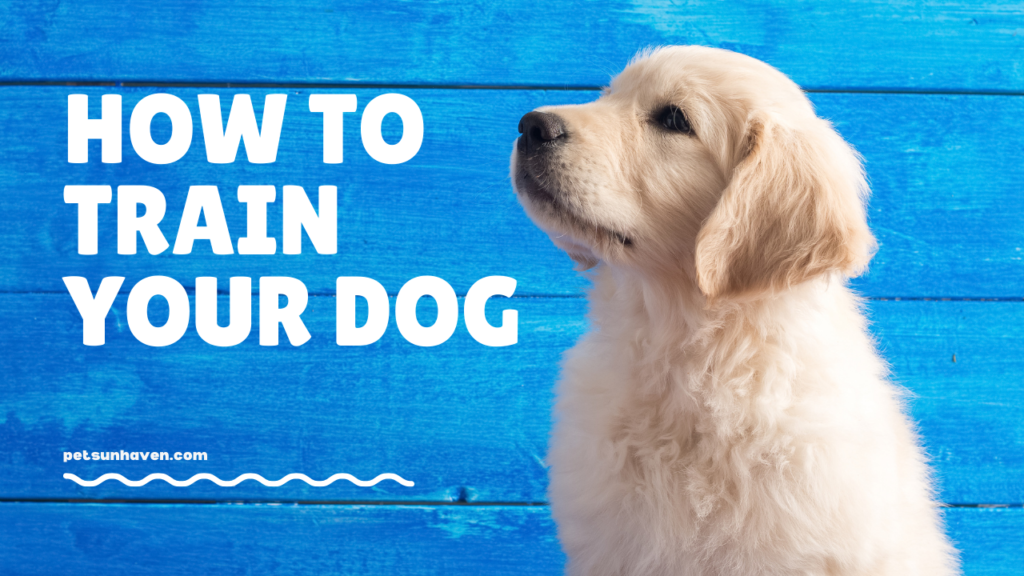Training your dog at home is one of the most rewarding experiences you can share with your furry friend. Not only does it build a strong bond between you and your dog, but it also ensures that your pet is well-behaved and happy. Home training is convenient, cost-effective, and can be tailored to suit your dog’s specific needs.

In this article, we’ll explore 10 essential tips for training your dog at home. Whether you’re a first-time dog owner or looking to improve your training techniques, these tips will guide you toward success.
Tip 1: Start with Basic Commands
Before diving into advanced tricks, it’s crucial to establish basic commands like “sit,” “stay,” and “come.” These foundational commands are the building blocks for more complex behaviors. Starting with the basics helps your dog understand the concept of following commands and makes further training much easier.
Why Basics Matter:
Basic commands ensure that your dog listens to you and can safely navigate various environments. They also lay the groundwork for more advanced training.
Examples of Basic Commands:
- Sit: Helps in controlling your dog in different situations.
- Stay: Teaches your dog to remain in one place until instructed otherwise.
- Come: Ensures that your dog returns to you when called, a vital command for safety.
Tip 2: Use Positive Reinforcement
Positive reinforcement is one of the most effective methods for training your dog. This technique involves rewarding your dog for good behavior, which encourages them to repeat it.
Understanding Positive Reinforcement:
When your dog follows a command or behaves well, reward them immediately with treats, praise, or playtime. This creates a positive association with the desired behavior.
How to Implement It in Daily Training:
Every time your dog listens to a command or behaves well, reward them. Be consistent with your rewards so your dog knows what to expect.
Tip 3: Be Consistent
Consistency is key in dog training. If you’re not consistent with commands, rewards, and routines, your dog can become confused and less responsive.
The Role of Consistency in Training:
Dogs thrive on routine and clear communication. By consistently using the same commands and rewarding good behavior, you help your dog understand what’s expected.
Tips to Maintain Consistency:
- Use the same word or phrase for each command.
- Ensure everyone in the household follows the same training methods.
- Stick to a regular training schedule.
Tip 4: Keep Training Sessions Short
Dogs, especially puppies, have short attention spans. Keeping training sessions brief ensures that your dog stays focused and engaged.
The Ideal Length for Training Sessions:
Aim for sessions that last between 5 to 10 minutes, especially in the beginning. As your dog becomes more accustomed to training, you can gradually increase the duration.
How to Keep Your Dog Engaged:
Use high-energy, enthusiastic tones, and make sure to end sessions on a positive note. If your dog is losing interest, it’s better to end the session and try again later.
Tip 5: Socialize Your Dog
Socialization is a critical aspect of training that helps your dog become comfortable around other animals, people, and different environments.
The Importance of Socialization:
A well-socialized dog is less likely to develop behavioral problems like aggression or fearfulness. Socializing also makes it easier to train your dog in various settings.
How to Safely Introduce Your Dog to New Environments:
Start by introducing your dog to new experiences gradually. Take them to parks, on walks in different neighborhoods, and allow them to interact with other dogs under supervision.
Tip 6: Use Treats and Rewards Wisely
While treats are a powerful motivator, it’s essential to use them wisely to avoid over-reliance.
Choosing the Right Treats:
Opt for small, healthy treats that are easy to digest. High-value treats like bits of chicken or cheese can be particularly effective during training.
Balancing Treats with Other Rewards:
Incorporate praise, toys, or playtime as rewards, so your dog doesn’t become dependent on treats alone. This also keeps training varied and exciting.
Tip 7: Understand Your Dog’s Behavior
Every dog is unique, with its own set of behaviors and quirks. Understanding these behaviors can make training more effective.
Recognizing Behavioral Cues:
Pay attention to your dog’s body language and reactions. Signs of stress, excitement, or confusion can give you insights into how your dog is responding to training.
How to Respond to Common Behavioral Issues:
If your dog is struggling with a particular command or behavior, take a step back and assess the situation. You may need to adjust your approach or give your dog more time to learn.
Tip 8: Practice Patience
Training a dog takes time and patience. It’s important not to rush the process or get frustrated if your dog doesn’t pick up on something right away.
Why Patience is Key:
Dogs can sense your emotions. Staying calm and patient will make your dog more comfortable and receptive to training.
Strategies for Staying Patient During Training:
- Focus on the small victories and progress.
- Remember that setbacks are normal.
- Take breaks if either you or your dog is getting frustrated.
Tip 9: Avoid Punishment-Based Training
Using punishment as a training method can lead to fear and anxiety in your dog, making training more difficult in the long run.
The Dangers of Punishment:
Punishment can damage the trust between you and your dog. It may also cause your dog to associate training with negative experiences.
Alternatives to Punishment:
Focus on redirecting bad behavior rather than punishing it. For example, if your dog is chewing on something they shouldn’t, offer them a chew toy instead.
Tip 10: Make Training Fun
Training doesn’t have to be all work and no play. Incorporating fun elements can make the experience enjoyable for both you and your dog.
Incorporating Play into Training:
Use games like fetch or hide and seek as part of your training routine. This not only reinforces commands but also strengthens the bond with your dog.
How Fun Training Leads to Better Results:
A dog that enjoys training is more likely to be engaged and responsive. By keeping things fun, you’ll find that your dog learns faster and with greater enthusiasm.
Conclusion
Training your dog at home is a journey that requires time, patience, and dedication. By following these 10 tips, you’ll create a positive training environment that encourages learning and strengthens your bond with your dog. Remember, the goal is to make training a fun and rewarding experience for both you and your furry friend.
FAQs
What Age Should I Start Training My Dog?
It’s best to start training as early as possible, ideally when your dog is still a puppy. However, dogs of any age can learn with the right approach.
How Often Should I Train My Dog?
Daily training sessions are ideal, even if they’re short. Consistency is more important than the length of each session.
What if My Dog Doesn’t Respond to Training?
If your dog isn’t responding, try adjusting your approach. Consider changing the rewards, breaking down commands into smaller steps, or seeking advice from a professional trainer.
Can I Train an Older Dog?
Yes, you can train an older dog! While puppies may learn faster, older dogs are also capable of learning new commands and behaviors. The key is to be patient and persistent, as it may take a little more time for an older dog to adapt to new routines.
How Can I Tell if My Dog is Learning?
Signs that your dog is learning include responding consistently to commands, showing enthusiasm during training sessions, and displaying improved behavior over time. If your dog seems to understand and follow your cues more regularly, it’s a good indication that they are making progress.


